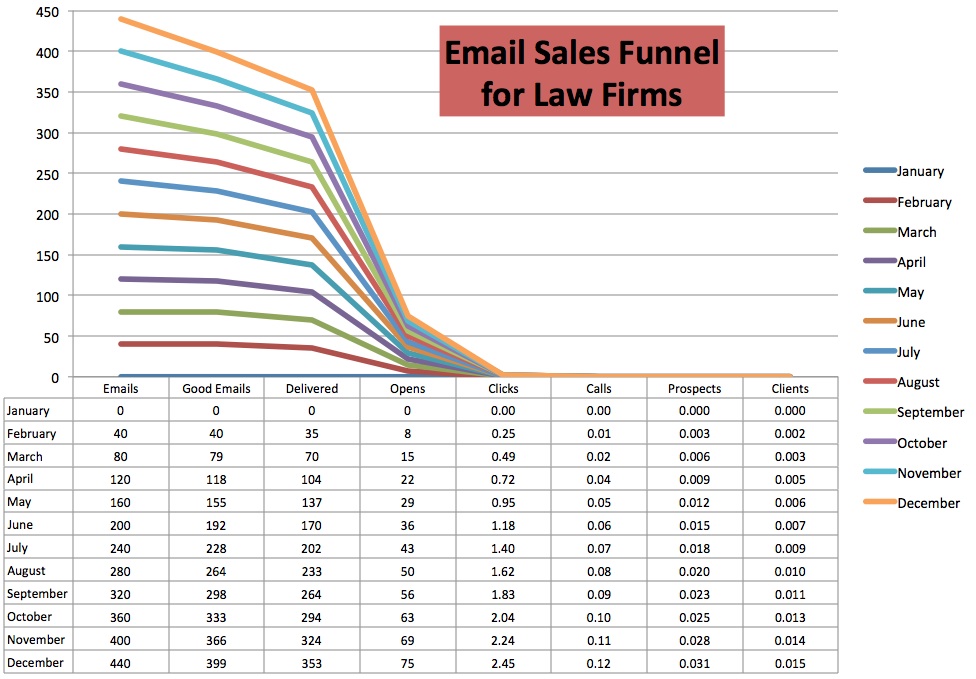Why It Takes 5 Years for Email to Generate 1 Law Firm Client
Fortunately, lawyers haven’t stumbled all over themselves in a rush to adopt email marketing in the same way they have social media . . . BUT I still see email marketing being pitched as a primary client development tool. And rarely does the email newsletter pan out. The reality is, there are many many steps in the law firm email sales funnel – and every step can torpedo this channel. Here’s the simple math you need to consider when investing in an email marketing campaign:
- Decay Rate of Email List: Emails don’t tend to hang around for long – people change jobs, cancel addresses or simply abandon a legacy address. Towerdata states roughly 2% of an email list is lost every month.
- Deliverability Rate: Not all commercial email ever makes it through to an inbox due to spam filters and the like. ClickZ sites an 88.5% deliverability rate for commercial email.
- Open Rate: Mailchimp sites an open rate for 21.33% for legal emails – essentially meaning for those emails that do make it to an inbox – only one in five is actually opened.
- Click Through Rate: The same Mailchimp study points to a 3.25% click through rate (note that a good email should have your phone number so they can call you directly.)
Now, let’s make some optimistic assumptions about law firm marketing:
- Small to medium sized law firms get roughly 300-800 visits monthly. Let’s round up and call it 1,000 and very optimistically assume one out of every twenty five visitors signs up for your newsletter (resulting in 40 addresses a month).
- Visitors to law firm websites call at a rate between roughly 2 and 5% depending on the quality of the site’s marketing. We’ll use 5%.
- Of phone calls to law firms, roughly one in four is from a qualified prospect – i.e. a potential good client.
- Law firms close half of the business they want.
That’s a sales funnel with a daunting eight steps. Here’s what it looks over a year if we deploy a monthly email campaign:
So after a year, based on these assumptions (and feel free to come up with your own conversion assumptions and play this out for yourself), that’s 0.015 clients – – – – put more simply, even with these optimistic growth rates, on average it will take four and a half years to generate one client. Some more back of the napkin math: between content development, CAN SPAM compliance, unsubscribes, email capture, we spend 2 hours developing each email at $100 an hour – that’s a cost per client of $10,800.
The Exception
By all means use email (even automated campaigns) to proactively communicate with vetted prospects.
But harbor no illusions that this channel is the answer for filling the top of your sales funnel. The reality is, email requires a very large volume of recently sourced addresses to make an impact. Still hopeful? Consider the last time you easily gave up your email address online – and then look at the “Promotions” or “SPAM” tab/folder on your email provider and consider the last time you opened one of them, let alone clicked through.
Most law firms, simply can’t generate enough addresses in the top of the email marketing funnel for anything to come out of the bottom.


Interesting post, Conrad. Makes a lot of sense, especially for practice areas that have irregular and unpredictable client acquisition (e.g. personal injury attorney). What about federal practice areas? Do you think the same applies here even though the practice area is seasonal and/or more predictable (e.g. tax attorney)?
Overall the difficulties of collecting emails, delivering and actually having them opened and read make the email a volume game. The only way to ROI email out effectively is to have the cost of generating email amortized over a very very large number of addresses – and your average law firm just can’t generate that volume.
I might have missed this, but I don’t think I did. One very big reason for low email campaigns is the laws governing lawyers and the way they advertise. The process just to get an email approved is massive. They have to have it reviewed and vetted by the bar ass. The time it takes for that is stupid long. By the time they have the second email ready to go it’s been 4-54 months from the first. no consistancy and to long of a time gap to keep anyone interested in the newsletter.
Email that people agree to receive shouldn’t be an ethics issue, or a bar regulation issue. But, let’s leave that aside for the moment since the focus of Conrad’s post is the “effectiveness” of using email to get business.
Yes, most lawyers can’t make use of a lot of marketing tools (including email communication). They can’t make use of SEO without expert help. They can’t set up websites without help either.
But, the question I ask is this: can a lawyer who understands the proper use of email communication (within an overall marketing strategy that’s sensible and well-thought out) use it effectively?
The answer isn’t “no, because open rates are low in the legal realm.” The answer depends on how the lawyer uses email to engage with clients. If the lawyer can generate leads by providing useful information for free, and then follow up periodically in a strategic way (note the constant use of the word “strategic”) then he might generate enough business to make the email communication TOTALLY WORTH IT.
Direct mail marketers have open rates of 1% and if you get to 2% you’re doing well. They make money because they have a strategy and they do A/B split testing, and have “controls” that they measure results again as they test.
Bottom line: nothing is so simple in marketing as “well, just do this, or just avoid this.” A coherent strategy takes into account a broad view, and then selects things that (1) generate quality leads (in an ethical professional way), (2) follow up with those leads in a way that builds trust, and (3) converts some of those leads to business. And if that all happens with the acquisition cost being well below the revenue generated then the strategy is solid.
A good strategist considers all the tools, and figures out how much emphasis to give to each one. We all have to remember that just because we know how to hammer really well, that doesn’t mean that all of the important problems look like nails.
Wonder how law firms feel about email advice from a marketer that LIES to get his website domain.
Why not just build your own reputation from scratch like the rest of us did.